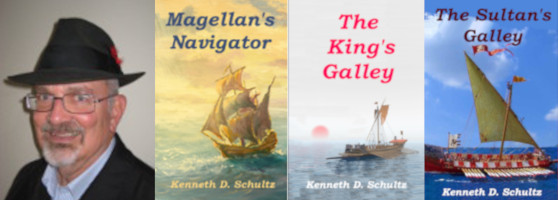The Victoria departed Tidore on December 21, 1521 with sixty-two souls aboard, forty-nine Europeans and thirteen Moluccans. El Cano was Captain, having been elected by the crew. Albo was the Pilot, Miguel de Rodas was the Master, while Juan de Acurio was the Mate. Interestingly, all four men were originally mates on four of the five original ships. El Cano was Basque, Acurio Castilian, and Albo and Miguel Greek. Antonio Pigafetta was perhaps the other most senior person aboard. All the men were united in the desire to return to Spain, which isn’t to say that all trusted one another. El Cano had sided with the mutineers. All the other men had actively or passively supported Magellan. It is notable that Pigafetta never names El Cano in his book, leading me to believe he had a low opinion of him.
Their first challenge was to sail through the maze of the East Indies so they might launch themselves across the Indian Ocean. Despite taking on pilots at Tidore, this took nearly two months, and it wasn’t until February 13th that the Victoria lost sight of the Indies. An apprentice seaman and a cabin boy jumped ship at Timor, probably deciding life in the tropical islands was preferable to facing starvation and scurvy.
A month into the transit of the Indian Ocean, they came upon an isolated island, now known as the Ile of Amsterdam. They attempted landfall. Any fresh provisions would have been welcome, but unable to find an anchorage, they sailed on. (The island remains uninhabited other than a research station.)
Finally, on May 8th, 1521 they sighted Africa. Two Europeans had died in the transit of the Indian Ocean. Their food stores already dangerously low and mostly rice remained. The men were weakening, and soon scurvy and starvation would exact a toll unless they got fresh food. It took eleven days to actually round the Cape, as the tired men had to tack against westerly winds, and they once had to make repairs to a mast after a storm. Two more men succumbed while rounding Africa.
Once having passed the Cape they were able to obtain firewood and water, but no food. The ravages of starvation and scurvy now accelerated with men dying each week. By July 9th, less than two months after rounding the Cape and over four thousand miles later, eight more Europeans had died despite once making landfall on the African coast…and finding no provisions. The Moluccans doubtlessly fared worse. We don’t know the timing of their deaths, but of the thirteen that sailed from Tidore, only three survived to reach Spain, which was a much higher death rate than for the Europeans. During this time, Martin de Magellan died. He was a nephew of Magellan who had sailed on the Concepcion.
By early July they were still two thousand miles from Spain and without enough food to sustain them until there. They voted to risk getting provisions at the Portuguese Cape Verde Islands. They entered the Portuguese port of Sao Tiago on July 9th. They told the Portuguese a woeful tale of sailing from the Caribbean and being blown off course by a hurricane. Initially this was believed despite El Cano purchasing food by payment of cloves! At this point there were probably thirty-four Europeans still aboard the Victoria (another seaman having recently died) and three Moluccans. On July 14th, the longboat with thirteen men went ashore for one last load of rice. It didn’t return.
One of the men ashore had blabbed. The Portuguese demanded El Cano surrender. El Cano attempted to negotiate to no avail. They could surrender, to the uncertain mercy of the Portuguese. Or they could sail, despite all the men still suffering the ravages of the voyage, some worse than others. Also, if they sailed, they would be leaving thirteen of their shipmates behind. The remaining crew decided to sail with a badly depleted and sick crew of twenty-five, twenty-two Europeans and three Moluccas.


